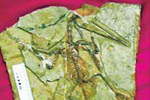Society
A lunar eclipse turns the moon pink
Updated: 2010-12-22 11:10
(chinadaily.com.cn)
Skygazers with a clear view in North America and Europe were greeted with a celestial treat in the early morning hours on Tuesday, as a unique total lunar eclipse was to transform the Moon pink, coppery or even a blood red.
Coinciding eerily with the northern hemisphere's mid-winter solstice - for the first time in almost four centuries - the eclipse showed the sun, the Earth and its satellite as they directly aligned, with the moon swinging into the cone of shadow cast by its mother planet.
Despite being in shadow, the moon did not become invisible, though, as there is still residual light that is deflected toward it by our atmosphere.
Most of this refracted light is in the red part of the spectrum and as a result the Moon, seen from Earth, turns a reddish, coppery or orange hue, sometimes even brownish.
NASA's veteran eclipse expert Fred Espenak explained that while the entire event was to be visible from North America, Greenland and Iceland, Western Europe sees the beginning stages before moonset and Western Asia gets the later stages after moonrise. The eclipse was to run for three and a half hours, although the stage of total eclipse - when the moon heads into the "umbra" cast by the Earth - was to last for one hour and 12 minutes.
Two factors affect an eclipse's color and brightness, said the US astronomy magazine Sky & Telescope.
"The first is simply how deeply the moon goes into the umbra. The center of the umbra is much darker than its edges," it says. "The other factor is the state of Earth's atmosphere along the sunrise-sunset line. If the air is very clear, the eclipse is bright. But if a major volcanic eruption has polluted the stratosphere with thin haze, the eclipse will be dark red, ashen gray or blood-black."
Lunar eclipses have long been associated with superstitions and signs of ill omen, especially in battle.
The defeat of the Persian king Darius III by Alexander the Great in the Battle of Gaugamela in 331 BC was foretold by soothsayers when the moon turned blood-red a few days earlier.
A solar eclipse happens when the moon swings between the Earth and the sun.
(中国日报网英语点津 Helen 编辑)

Todd Balazovic is a reporter for the Metro Section of China Daily. Born in Mineapolis Minnesota in the US, he graduated from Central Michigan University and has worked for the China Daily for one year.
Specials

President Hu visits the US
President Hu Jintao is on a state visit to the US from Jan 18 to 21.

Ancient life
The discovery of the fossile of a female pterosaur nicknamed as Mrs T and her un-laid egg are shedding new light on ancient mysteries.

Economic Figures
China's GDP growth jumped 10.3 percent year-on-year in 2010, boosted by a faster-than-expected 9.8 percent expansion in the fourth quarter.